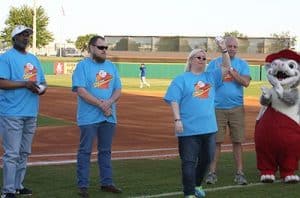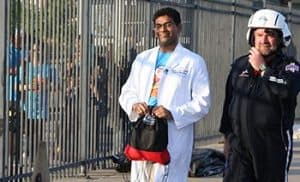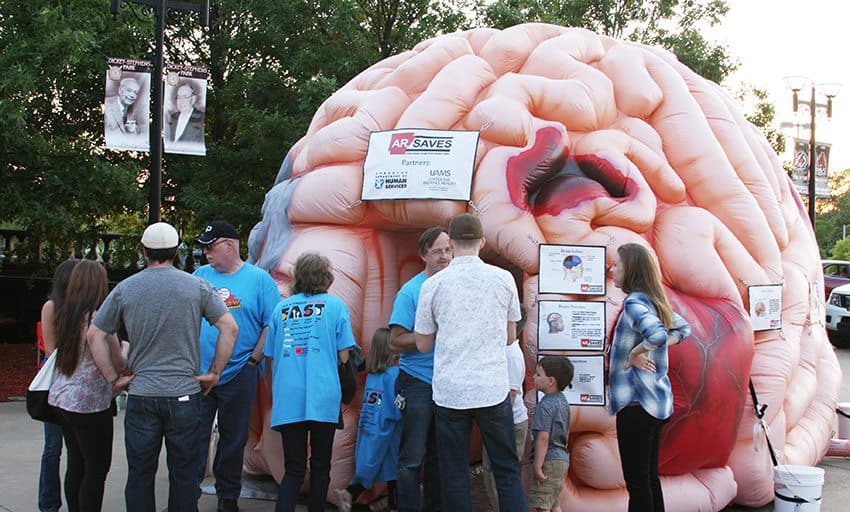Mega Brain Debuts at Strike Out Stroke Nights
| May 18, 2016 | The 5-year-old boy’s eyes were wide with wonder outside busy Dickey-Stephens Park in North Little Rock as he spied not his baseball hero but the giant, inflatable Mega Brain.

As mascot Otey the Possum applauds, far right, AR SAVES stroke survivors stand and are recognized at Strike Out Stroke Night at Dickey-Stephens Park in North Little Rock. Left to right, they are, the Rev. William Robinson, Dustin Martinez, Shannon Coles and Michael Pafford.
Mega Brain was there May 5 for Strike Out Stroke night, an event to raise public awareness about stroke that is organized by AR SAVES (Arkansas Stroke Assistance through Virtual Emergency Support), a University of Arkansas for Medical Sciences (UAMS)-led program.
Holding a life-size plastic model of a skull and brain, UAMS’ Rick Washam stood by as the boy along with his parents approached him and Mega Brain. Washam greeted them warmly and explained brain anatomy and how the models in his hand and behind him illustrated areas of stroke, trauma and disease that affect the brain.
The boy afterward said one of the things he had learned from Washam was the importance of wearing head protection when riding his bike.
Adults also gathered around Mega Brain and asked David Wollard, B.S.N., R.N., questions. One woman, who is scheduled to have brain surgery in June, asked Wollard about tumors and in turn, she was able to use the inflatable model to explain the brain and surgery to her nephew.
Washam and Wollard both work in the AR SAVES program, Washam as a health educator manager and Wollard as an outreach nurse. The AR SAVES program is a partnership of the UAMS Center for Distance Health, the state Department of Human Services and 48 Arkansas hospitals.

A young baseball fan holds up a FAST card of stroke symptoms at Arvest Park in Springdale during Strike Out Stroke Night there. The FAST acronym stands for Face, Arm, Speech and Time and reminds folks of the symptoms of facial drooping, arm numbness or immobility, slurred speech and the necessity of timely treatment.
To help Arkansans learn how to survive stroke, AR SAVES leadership, staff, volunteers and community partners organize or are a part of dozens of events throughout the year, including “Strike Out Stroke Night” nights at ballparks in northwest Arkansas in April and North Little Rock in May.
“This is an important part of UAMS’ mission — reaching out to other areas of the state and helping local physicians and nurses to identify and treat patients with stroke and improve the patients’ outcomes,” said Renee Joiner, director of AR SAVES.
AR SAVES uses a high-speed video communications system to help provide immediate, life-saving treatments to stroke patients 24 hours a day. The real-time video communication enables a stroke neurologist to evaluate whether emergency room physicians should use a clot-busting blood thinner within the critical three-hour period following the first signs of stroke.
Before the North Little Rock game, a helicopter brought stroke neurologist Sanjeeva Reddy Onteddu, M.D., AR SAVES medical director, to deliver baseballs for the game’s first-pitch ceremony, all strikes against stroke. In Springdale on April 7, another helicopter transported Washington Regional Medical Center neurologist Margaret Tremwel, M.D., to Arvest Park to do the same thing.
AR SAVES stroke survivors were honored at both games serving as a reminder to others that getting to the hospital quickly can prevent stroke death and disability.

Sanjeeva Reddy Onteddu, M.D., AR SAVES medical director, delivers baseballs to Dickey-Stephens Park along with the helicopter pilot who flew him there.
A stroke survivor at the North Little Rock ballpark threw the first strike before the baseball game, and other stroke survivors were recognized on the field as well.
Volunteers from AR SAVES sites around the state worked at stroke education booths, and brain-shaped stress toys were given out to game attendees.
The 18-by-14-by-12-foot, inflatable Mega Brain made its first appearances at each ballpark. Numerous people at the games walked through the anatomically correct, inflatable model of the human brain. At many public events, the Mega Brain has demonstrated its popularity and effectiveness as a tool for teaching others about the human brain, stroke and other neurological injuries and diseases.
Arkansas ranks sixth in the nation in stroke death rates. Surviving a stroke is becoming more likely as more community hospitals join the SAVES network.
